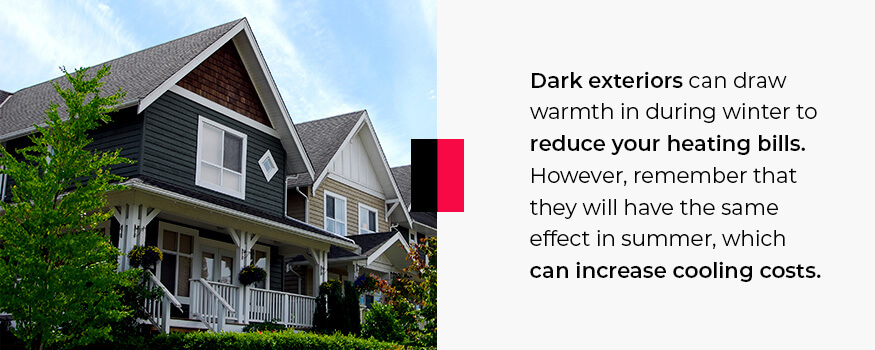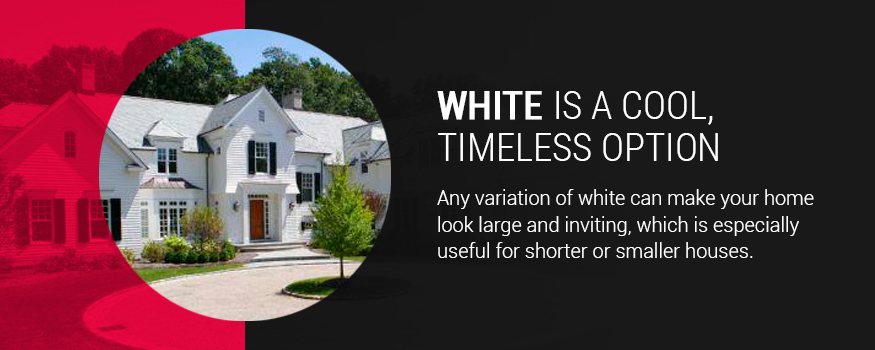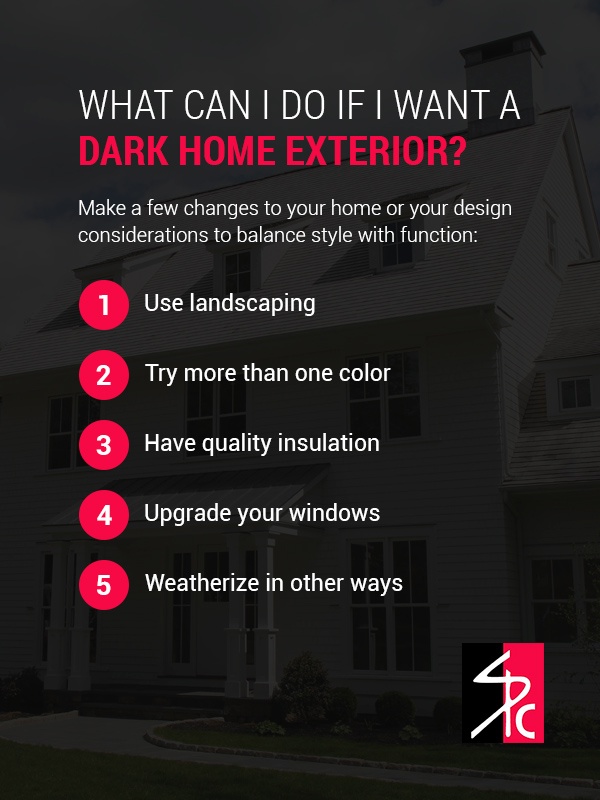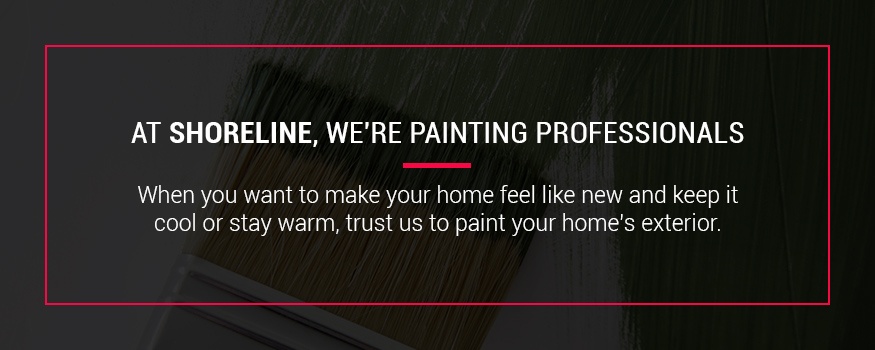How Does Exterior Color Affect Internal Temperature?
February 26, 2024
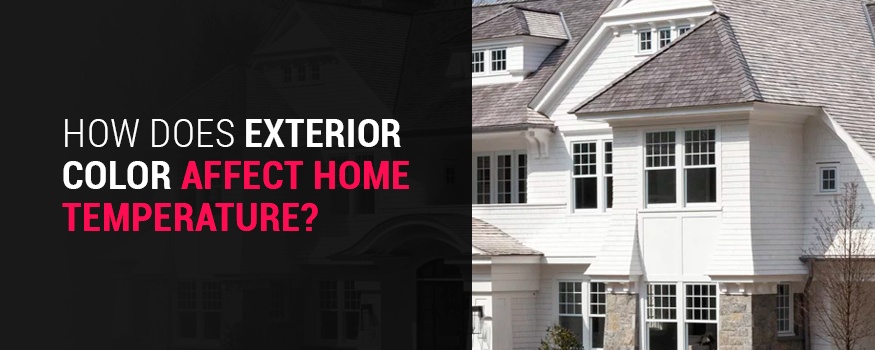
Repainting is a worthwhile way to add value to your home, especially if you’re considering selling. A fresh coat of quality exterior wall paint can offer a significant return on investment. But you should consider more than aesthetic preferences when picking out the perfect color of fresh paint for your home.
The exterior colors you choose will impact the indoor temperatures. Learn which colors reflect and absorb heat before you start repainting your home.
The Science Behind Exterior Paint Colors and Home Cooling Efficiency
While darker colors absorb sunlight and convert it into heat, lighter colors are reflective. As a result, dark-colored surfaces will get warmer quicker in sunlight than light-colored surfaces that can repel heat.
Several factors impact indoor temperatures. For example, homes built with denser materials absorb and hold heat better. Energy-efficient efforts like sealing cracks and gaps in the walls, maintaining your HVAC system, replacing windows and installing a programmable thermostat can also make your house more comfortable year-round.
The roof color, size and number of windows and how much sun your home receives are essential considerations when repainting your exterior for efficiency. South-facing homes receive maximal direct sunlight, while north-facing homes tend to get softer sunlight throughout the day. East- and west-facing homes receive the most light during sunrise or sunset, respectively.
An exterior color scheme that considers all these factors can create considerable energy savings.
How Much Does Paint Color Affect House Temperature?
The exterior color of your home may have more of an impact on the temperature inside than you think. There is no set percentage or amount of this effect, though, because paint color isn’t the only consideration when it comes to your home’s interior temperature. How much the exterior of your home impacts the temperature inside will depend on a handful of factors, including:
- The roof color and whether it’s also light or dark
- How much of your home is light or dark
- The amount, size and quality of windows you have
- How much sunlight or shade your house is in
- Your indoor heating and cooling solutions
- The material throughout your home’s exterior
So does the color of your house affect the temperature inside? Yes, but it isn’t the only factor. Changing the color of your home’s exterior, however, is a great place to start if you want to keep your home cooler or warmer. You just have to know which color to choose.
Dark vs. Light Exterior Paint — A Comparative Analysis
Which color absorbs more heat? To answer that question, look at light reflective values. Darker, duller colors have low LRV and can attract most of the sun’s heat, which transfers into your home. On the other hand, lighter and brighter colors can direct the sun’s heat away, keeping temperatures inside more comfortable.
The Thermal Dynamics of Dark Paint
Darker paint colors’ low LRV can attract up to 90% of sunlight, converting it into heat and swiftly transferring it into your home. While the darkest black has a 0% LRV, lighter shades of black and gray will have a higher value, attracting less light.
Evaluating the Financial and Environmental Impact
Dark exteriors can draw warmth in during winter to reduce your heating bills. However, remember that they will have the same effect in summer, which can increase cooling costs.
While it’s not economical to repaint your home with each changing season, you can decide whether your family is generally overly warm or cold and repaint to counter the current indoor temperatures. Additionally, replacing or upgrading your insulation to assist with temperature control is worthwhile in any season.
What to Consider When Choosing an Exterior Home Color
When it comes to choosing the exterior color of your home, you’ll have to set priorities and consider what you want from your exterior color. Many homeowners consider factors like these to prioritize as they pick colors for their homes:
- Interior temperature: You’re most likely prioritizing this aspect of a new exterior color. But you have to consider whether you want your home to be hotter or cooler based on the exterior color. That decision could depend on the climate where you live and other various qualities of your home.
- Existing features: If you’re working with Shoreline Painting to change the colors of exterior walls, you may wish to leave brick and stonework their existing colors. You’ll then have to select a color that complements the existing features of your home for a seamless adjustment to your style.
- Other changes: Perhaps you’re making other exterior changes to your home. New roofing and a new roof color will influence the temperature in your home and what colors you can select for your exterior walls. At Shoreline, we can change stucco and siding exterior walls with paint and your brick, as well, for a total transformation. Whatever you choose to change, you’ll want your accents and exterior walls to complement each other, so make those decisions at the same time.
- Your style: While the exterior color of your home does influence the temperature inside, you don’t have to compromise with a color you don’t enjoy. You should love looking at your newly painted house as you come home, so you shouldn’t pick a color based only on how it impacts temperature. Choose something that fits your tastes so you’re happy with the result. Make different changes to benefit the temperature inside your home and don’t compromise on style.
- Your neighbor’s style: If your home is close to others on your block, you may not want to choose a color that clashes with your neighbors’ homes. Feel free to select a unique color if that suits your tastes — it’s your home, after all — but try to pick a color that coordinates with the houses in your area. You’ll get a beautiful new color that stands out without looking out of place on your street.
With those considerations in mind, dive into selecting a color to refresh the outside of your home. Certain colors are more versatile, popular and functional than others, especially if you’re considering the color’s impact on the interior temperature.
The Fresh Appeal of White
White exteriors are perfect for homes in hot climates. The bright tones will reflect warmth to keep your energy bills low. Lighter colors also complement modern trends, so this palette is an excellent choice to boost property appeal to buyers.
When choosing white exteriors, ultra white or pure white is not your only option — Chantilly lace white, ivory, pearl, porcelain and cream are more unique options to consider.
If you feel that white is a bit too basic for your home or your style, choose fun or unique accents for the rest of your home’s exterior. Unique brick or stonework or pops of color on your home’s accents will infuse your house’s exterior with your style without much of an impact on the interior temperature. Go for a white house with colorful accents in areas like:
- Shutters
- Doors
- Door frames
- Window frames
- Porches
- Railings
- Dormers
The Warmth of Black
A dark exterior color palette can create a uniquely enchanting contrast with the surrounding landscaping. But it’s best to paint strategically when going this route. If you live in a cooler climate, like that of coastal Connecticut and New York, you may not mind having an exterior color that keeps your house warm. That could have a positive impact on heating costs during the cold seasons, especially if they last longer than warm seasons. Otherwise, excessive heat buildup can become a problem because black is the most energy-efficient exterior paint color.
The best approach is to combine colors. Use a lighter shade like ash gray for 70% of your home, a darker charcoal accent for 20% and an even darker asphalt black for the remaining 10% of your home, which should make up gutters, door and window trims. Other black palettes use navy blues to help you achieve your desired aesthetic without increasing cooling costs in summer.
Homeowners may also avoid choosing black, navy blue or other dark colors because they’re known to fade with sun exposure. That means that over time, the sun would impact the appearance of your home, requiring touch-ups. But at Shoreline, we keep UV radiation resistance in mind as we select the paint for your home’s exterior and use high-quality, durable products that last for years to come. With Shoreline, you can choose a contemporary, sophisticated dark color for your exterior without worrying about fading and dulling.
Black and other dark colors are also known to highlight imperfections in a home’s exterior. With an exterior paint job from Shoreline, we’ll make sure to fix any imperfections and create a smooth surface for your home’s new paint color, so you get satisfying results even if you choose a darker color.
The Natural Ground — Grays and Heat Absorption
Gray comes in many shades, so its heat absorption properties will depend on your chosen hues. Gray palettes can be either light or dark, so you can incorporate gray into your exterior color scheme by considering your climate and your home’s insulation.
Lighter, brighter grays will reflect more light and heat than a darker, duller gray, meaning gray is a viable option for either impact on the interior temperature. Gray may be a good compromise between a refreshing white and a bold black for your home’s exterior, and it comes in plenty of shades and hues to suit your style.
From warm-toned grays to cooler, bluer ones, your options if you go gray are sure to suit your home and recent trends. Charcoal gray is a trending home color that’s on the darker side, while pale gray is also popular and adds a lighter pop of color to your home.
Exploring Beyond the Basics of Exterior Paint Colors
Whether you want to repaint to make your home warmer in cold weather or cooler in summer, you can add personal touches without impacting indoor temperature efficiency. Customize your color palette to include unique pops for your front door, window trims and gutters.
You can also create light and dark palettes in other color families, like teal, beige, greige, tan, taupe or gold. Each color family has dark and light hues and various tints and tones, leaving ample room for choice while staying within a single shade. So, even if you have your heart set on a unique exterior, you can create a color scheme that either warms or cools your home by choosing the right hues.
Consider those qualities in these trending home exterior colors:
- Beige is another versatile popular color, much like white, though it does provide some color. Its lighter variations give a warm color to your home but keep it cool on the inside.
- Yellow is a vibrant and quaint alternative to beige. In pale options, you get a subtle take on the popular color in a shade that will keep the interior of your home on the cool side.
- Blue creates a calm feeling for your home. The cool color keeps your house cool in its lighter variations, but navy blue is a dramatic option that helps heat your house.
- Red can add drama, but choose a muted shade for a cooler house and a trending color. Berry shades are also fun and popular, and you can select a paler variety for a unique home exterior that keeps the interior cool.
- Green in an earthy, olive tone makes your home feel natural. Olive is often a darker shade, meaning it could heat your home, but not as much as a black exterior. Choose a pale olive for a cooling option.
What Can I Do If I Want a Dark Home Exterior?
A dark house will stand out on your block or in your neighborhood, so you may want a dark exterior. If you want the dramatic look but have concerns about how much paint color affects house temperature, make a few changes to your home or your design considerations to balance style with function:
- Use landscaping: If you have ample yard space around your home, use landscaping to help provide shade. The NREL explains that shade can reduce the temperature inside your home by up to 20°F, which helps offset the heat from a dark exterior. Tall, full trees can help block the sun’s light from heating your house, but don’t add too much landscaping. You’ll want to balance your landscaping with how much of your home’s beautiful exterior you can see for the best curb appeal.
- Try more than one color: Choose black as an accent color to tie in the bold look and balance it with lighter colors that can help keep your home cool. Black can make a statement for shutters, stonework and different accents on your home’s exterior, and you can choose complementary, lighter colors elsewhere that will keep your home cool.
- Have quality insulation: Insulating your home helps keep the heat out in the summer and the cold out in the winter. The attic, in particular, can heat your home in the warmer seasons, so start there with proper insulation to get the dark exterior you’ve been dreaming of.
- Upgrade your windows: According to the NREL, about 40% of the heat that builds up in your home comes through your windows. That’ll vary based on the amount, placement and size of your windows, but upgrading to newer windows can help insulate your home better. You can also use reflective coatings on your existing windows to help bounce away light and heat.
- Weatherize in other ways: The NREL explains that caulking and other measures seal and protect your home to maintain the right interior temperature. At Shoreline, we’re sure to caulk areas along the exterior of your home that need to be filled or re-caulked, giving you more protection and weatherization.
Repaint Your Home’s Exteriors for Better Indoor Temperatures With Shoreline Painting
Quality products and expert artistry are essential when repainting a home’s exteriors. Shoreline Painting is a family-owned business and a Fine Paints of Europe Certified Painter with over 35 years of experience.
We can transform your home for energy efficiency with a luxury coat of paint. If you are still undecided about which color scheme is best for your home, take advantage of our color consulting services. We can help you find the most suitable palette to improve indoor temperatures.
Contact us online or read more about our exterior painting services.
Recent Posts & Guides








